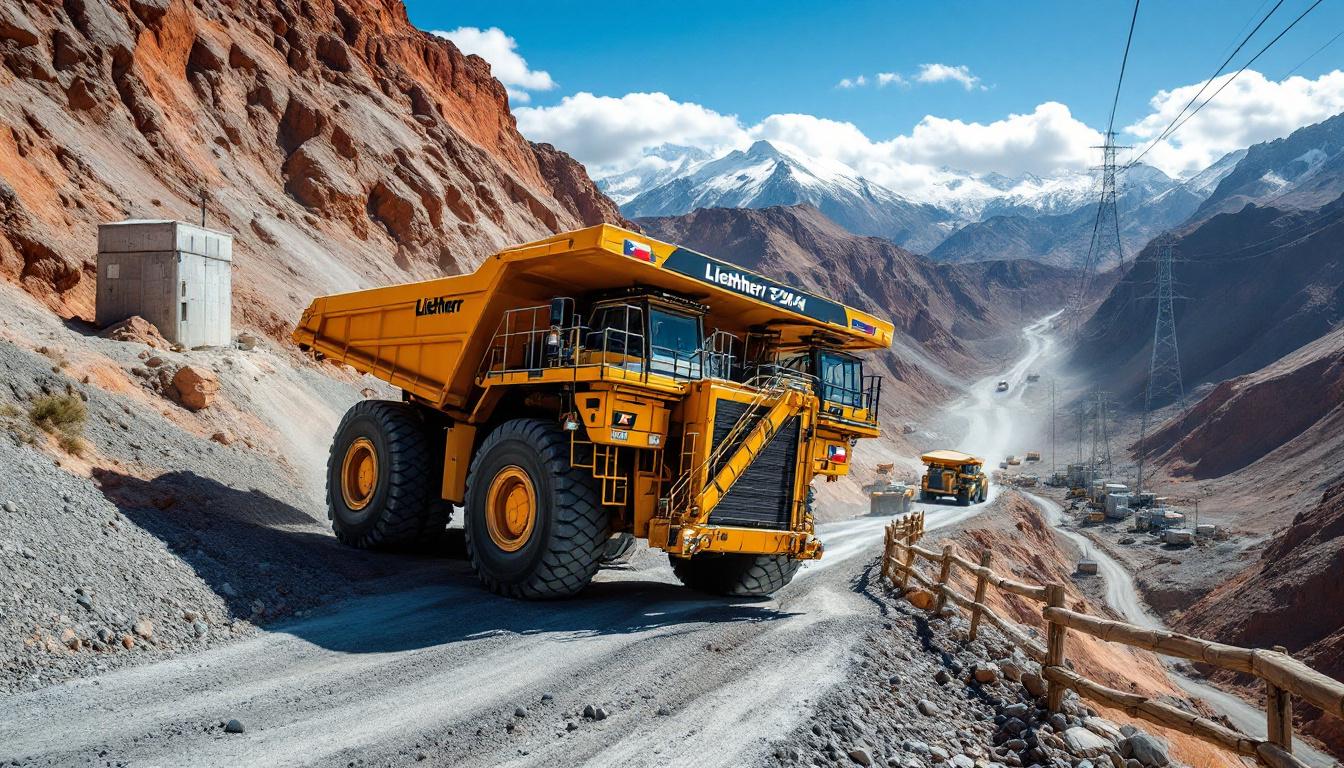Rwanda's Mineral Smuggling Crisis: The Hidden Supply Chain
In the heart of Central Africa, a complex web of mineral smuggling has reached unprecedented levels, according to recent United Nations investigations. The illicit flow of valuable minerals from eastern Democratic Republic of Congo (DRC) through Rwanda threatens global supply chains, fuels regional conflict, and undermines international efforts to ensure ethical sourcing of critical materials used in everyday technology.
UN Findings Reveal Extensive Cross-Border Trafficking
Recent United Nations investigations have uncovered alarming evidence of systematic mineral smuggling from rebel-controlled territories in eastern Congo through Rwanda. According to the UN report, "Rwanda is smuggling minerals from rebel-held areas in eastern Congo at unprecedented levels," with a particular focus on the strategic "3Ts" – tin, tantalum, and tungsten.
These minerals, essential components in electronics manufacturing, are being extracted from conflict zones under dubious circumstances, then transported across borders where their origins are obscured, effectively laundering them into legitimate global supply chains.
The smuggling networks operate with sophisticated logistics, exploiting regulatory gaps and leveraging political instability to maintain their operations. Eastern Congo's mineral-rich territories, particularly in North Kivu province, have become extraction hotspots where oversight is minimal and armed groups maintain territorial control.
M23 Rebels: The Extraction Force Behind Mineral Looting
At the center of this illicit mineral trade are the M23 rebels, who have established strategic control over mineral-rich territories in eastern Congo. According to UN findings, "Rwanda-backed M23 rebels [are] looting tin, tantalum, and tungsten and then funneling them through Rwanda."
This systematic exploitation follows a calculated pattern:
- M23 forces secure mining areas through military control
- Local miners are coerced into extraction activities
- Minerals are collected through informal taxation systems
- Transportation networks move resources across porous borders
- Materials enter processing facilities where origins are obscured
The revenue generated from these operations provides critical funding for ongoing rebel activities, creating a self-perpetuating cycle of conflict and resource exploitation. While precise revenue figures remain difficult to verify, the scale of operations suggests millions of dollars flow through these channels annually.
"The systematic looting of minerals by armed groups represents not only a humanitarian crisis but a fundamental challenge to global supply chain integrity," notes the UN report, highlighting how conflict financing through mineral smuggling undermines both regional stability and international business ethics.
How Does This Smuggling Operation Work?
Concealment Tactics and Origin Laundering
The mineral smuggling process relies on sophisticated concealment tactics designed to mask the true origins of conflict minerals. These networks employ multiple strategies to evade detection:
- Documentation falsification: Paperwork is altered to claim Rwandan origin for Congolese minerals
- Border crossing strategies: Utilization of remote, unmonitored crossing points
- Intermediary layers: Multiple transfers between extraction and export obscure the chain of custody
- Processing manipulation: Minerals undergo processing that makes origin verification more difficult
These activities directly "undermine global mineral traceability systems," as noted in the UN report. The strategic use of processing facilities that "wash" conflict minerals into legitimate supply chains creates significant challenges for downstream buyers attempting to maintain ethical sourcing standards.
Impact on Global Mineral Traceability Systems
The sophisticated smuggling operations have exposed critical weaknesses in existing mineral certification frameworks. Despite significant investments in traceability systems like the Responsible Minerals Assurance Process (RMAP) and OECD Due Diligence Guidance, smugglers continue to find ways to circumvent these safeguards.
Key vulnerabilities include:
- Inadequate physical monitoring at remote border crossings
- Limited technological capability to verify mineral origins
- Insufficient resources for comprehensive supply chain audits
- Economic incentives that reward certification evasion
- Competing regulatory frameworks with inconsistent enforcement
These challenges create a perfect environment for illicit minerals to enter legitimate supply chains, often with falsified documentation that gives the appearance of compliance while masking their true conflict origins.
Political Implications of the Rwanda-Congo Mineral Conflict
Recent Peace Negotiations Under Threat
The UN's findings on mineral smuggling came "just days after" a U.S.-brokered peace deal between Rwanda and Congo, casting a shadow over diplomatic efforts to stabilize the region. This timing raises serious questions about the viability of peace agreements when economic incentives for conflict remain firmly in place.
The peace deal, aimed at reducing tensions between the two nations, included provisions related to proxy militia support and mineral governance. However, the continued flow of conflict minerals suggests that economic motives may undermine political commitments, particularly when valuable resources remain accessible and enforcement mechanisms remain weak.
Regional experts note that previous peace agreements have struggled to address the fundamental economic drivers of conflict, with mineral resources consistently remaining a flashpoint for tensions between Rwanda and Congo.
Rwanda's Response to UN Allegations
The Rwandan government has categorically denied the UN's accusations regarding mineral smuggling and M23 support. Official statements from Rwanda characterize the UN claims as "a misrepresentation of its security concerns" in the region, reflecting a longstanding position that their involvement in eastern Congo relates to legitimate security interests rather than economic exploitation.
This denial follows a pattern of diplomatic tensions between Rwanda and international monitoring bodies. The Rwandan government maintains that they have implemented robust mineral traceability systems within their own borders and reject assertions that their territory serves as a conduit for conflict minerals.
The contested narrative highlights the complex regional dynamics at play, where security concerns, economic interests, and historical grievances create a challenging environment for resolving mineral governance issues.
Global Market Impact of Congo-Rwanda Mineral Smuggling
Strategic Importance of 3T Minerals in Technology Supply Chains
The minerals at the center of this smuggling crisis – tin, tantalum, and tungsten – play critical roles in global technology manufacturing:
| Mineral | Key Applications | Supply Chain Significance |
|---|---|---|
| Tin | Solder, touch screens, semiconductor components | Essential for circuit board manufacturing |
| Tantalum | Capacitors, high-performance electronics | Crucial for miniaturization of devices |
| Tungsten | Circuit board components, vibration mechanisms | Critical for device durability and performance |
These minerals represent essential components in smartphones, computers, medical devices, and advanced military systems. Their strategic importance makes supply chain disruptions particularly concerning for technology manufacturers who face both ethical and practical challenges when sourcing these materials.
While not directly related to the 3T minerals in question, the Mining.com report notes that copper prices have reached approximately $10,000 per ton, a three-month high, with LME inventories down 65% year-to-date. This broader metals market volatility illustrates how supply uncertainties can drive significant price fluctuations.
Consequences for Technology and Manufacturing Industries
For technology manufacturers, the Rwanda and Congo mineral smuggling crisis creates multiple business challenges:
- Compliance risks: Companies may unknowingly source conflict minerals despite due diligence efforts
- Reputational damage: Associations with conflict financing can harm brand value
- Supply uncertainty: Reliance on potentially unstable or unethical supply chains
- Regulatory exposure: Increasing global regulations require verifiable conflict-free sourcing
- Cost implications: Enhanced due diligence processes add operational expenses
Many major technology companies have implemented specialized sourcing programs to mitigate these risks, including direct investment in traceability technologies and alternative sourcing strategies. However, the sophisticated nature of mineral laundering makes complete supply chain transparency extremely difficult to achieve.
Proposed Solutions to the Mineral Smuggling Crisis
Strengthening International Oversight
Addressing the mineral smuggling crisis requires coordinated international action focused on several key areas:
- Enhanced border monitoring: Deploying specialized teams at known crossing points
- Regional coordination mechanisms: Improving information-sharing between countries
- Economic incentives for compliance: Creating market advantages for verified conflict-free minerals
- Sanctions enforcement: Implementing targeted penalties against non-compliant actors
- Mining sector formalization: Supporting legitimate mining operations in conflict-affected areas
These approaches require substantial international investment and political will, particularly from countries involved in the technology supply chain who ultimately benefit from mineral resources extracted in Central Africa.
Technological Solutions for Mineral Tracking
Emerging technologies offer promising tools to combat mineral smuggling and improve supply chain transparency:
- Blockchain verification systems: Creating immutable records of mineral chain of custody
- Geochemical fingerprinting: Analyzing mineral composition to verify geological origins
- Satellite monitoring: Using remote sensing to track mining activities in conflict zones
- Digital certification platforms: Streamlining verification processes while reducing fraud opportunities
- AI-powered risk assessment: Identifying potential supply chain vulnerabilities before exploitation
Several pilot programs utilizing these technologies have shown promise, though widespread implementation faces challenges related to cost, infrastructure limitations, and the need for coordinated adoption across multiple stakeholders.
"Technological solutions alone cannot solve what is fundamentally a governance and security challenge," cautions a recent OECD report on mineral traceability. "They must be paired with meaningful political reforms and economic incentives that address root causes of conflict."
Understanding Rwanda-Congo Mineral Smuggling: Key Questions
What minerals are being smuggled from Congo through Rwanda?
The primary minerals being smuggled from eastern Congo through Rwanda are tin, tantalum, and tungsten – collectively known as the "3Ts." These minerals have significant value in global technology supply chains:
- Tin (cassiterite ore): Used in solder for electronics assembly and in touch screens
- Tantalum (coltan ore): Critical for manufacturing capacitors in electronics
- Tungsten (wolframite ore): Essential for creating vibration mechanisms and circuit components
Eastern Congo holds some of the world's richest deposits of these minerals, particularly in the North and South Kivu provinces where M23 and other armed groups maintain territorial control. The combination of mineral wealth and limited governance creates perfect conditions for exploitation.
How does mineral smuggling fuel conflict in the region?
The mineral smuggling operations create a self-perpetuating cycle of conflict through several mechanisms:
- Direct revenue generation: Armed groups use mineral profits to purchase weapons and supplies
- Territorial incentives: Resource-rich areas become strategic targets for military control
- Governance undermining: Parallel economic systems weaken legitimate state authority
- Corruption facilitation: Illicit mineral flows create opportunities for official corruption
- Regional tensions: Cross-border smuggling strains international relations
While the exact revenue figures remain difficult to verify, estimates suggest that millions of dollars flow through these illicit channels annually, providing critical financial support to armed groups like M23 that continue to destabilize the region.
What impact does this have on responsible sourcing initiatives?
The sophisticated mineral smuggling operations directly "undermine global mineral traceability systems," as noted by the UN report. This impacts responsible sourcing initiatives in several ways:
- Creates false confidence in supply chain due diligence
- Reduces financial incentives for legitimate mining operations
- Discourages corporate investment in traceability systems
- Complicates compliance with regulations like Dodd-Frank Section 1502
- Threatens consumer confidence in "conflict-free" claims
For companies attempting to maintain ethical supply chains, these challenges create significant business risks and may require more robust verification systems beyond current certification standards.
Looking Forward: Addressing Rwanda-Congo Mineral Smuggling
The mineral smuggling crisis between Rwanda and Congo represents a complex challenge that sits at the intersection of security concerns, economic incentives, and global supply chain ethics. Addressing this issue requires coordinated action from multiple stakeholders:
- Regional governments must strengthen border controls and mineral governance
- Technology companies need to invest in enhanced supply chain verification
- International organizations should provide technical support and monitoring
- Consumers can drive change through demanding transparent sourcing
Without comprehensive solutions that address both the economic incentives and security challenges underlying mineral smuggling, the cycle of resource exploitation and conflict financing will likely continue, with consequences that extend far beyond Central Africa to global mining landscape. The implementation of a robust critical minerals strategy could help address these issues, particularly as mining industry evolution continues to emphasize ethical sourcing.
Furthermore, initiatives like the European CRM facility and Congo lithium initiatives represent potential models for developing conflict-free supply chains that could be adapted to address the 3T minerals crisis.
Disclaimer: This article contains analysis of ongoing geopolitical situations and mineral markets that may evolve over time. The information presented reflects current understanding of complex issues that involve multiple stakeholders and disputed narratives. Readers should consult updated sources for the latest developments in this dynamic situation.
Ready to Stay Ahead of Critical Mineral Supply Disruptions?
Don't let supply chain challenges like Rwanda's mineral smuggling crisis impact your investments. Discover how Discovery Alert's proprietary Discovery IQ model delivers real-time notifications on significant ASX mineral discoveries, helping you identify actionable opportunities before the market reacts. Visit our discoveries page to see how major mineral discoveries can generate substantial returns.




